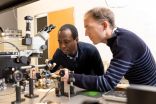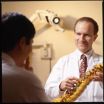Scientists estimate the total weight of plastic floating in the world's oceans
Nearly 269,000 tons of plastic pollution floating in the ocean
2014-12-10
(Press-News.org) Nearly 269,000 tons of plastic pollution may be floating in the world's oceans, according to a study published December 10, 2014 in the open-access journal PLOS ONE by Marcus Eriksen from Five Gyres Institute and colleagues.
Microplastic pollution is found in varying concentrations throughout the oceans, but estimates of the global abundance and weight of floating plastics, both micro and macroplastic, lack sufficient data to support them. To better estimate the total number of plastic particles and their weight floating in the world's oceans, scientists from six countries contributed data from 24 expeditions collected over a six-year period from 2007-2013 across all five sub-tropical gyres, coastal Australia, Bay of Bengal, and the Mediterranean Sea. The data included information about microplastics collected using nets and large plastic debris from visual surveys, which were then used to calibrate an ocean model of plastic distribution.
Based on the data and model, the authors of the study estimate a minimum of 5.25 trillion plastic particles weighing nearly 269,000 tons in the world's oceans. Large plastics appear to be abundant near coastlines, degrading into microplastics in the 5 subtropical gyres, and that the smallest microplastics were present in more remote regions, such as the subpolar gyres, which the authors did not expect. The distribution of the smallest microplastics in remote regions of the ocean may suggest that gyres act as 'shredders' of large plastic items into microplastics, after which they eject them across the ocean.
"Our findings show that the garbage patches in the middle of the five subtropical gyres are not the final resting places for the world's floating plastic trash. The endgame for micro-plastic is interactions with entire ocean ecosystems," says Marcus Eriksen, PhD, Director of Research for the 5 Gyres Institute.
INFORMATION:
Adapted by PLOS ONE from release provided by author
In your coverage please use this URL to provide access to the freely available paper: http://dx.plos.org/10.1371/journal.pone.0111913
Citation: Eriksen M, Lebreton LCM, Carson HS, Thiel M, Moore CJ, et al. (2014) Plastic Pollution in the World's Oceans: More than 5 Trillion Plastic Pieces Weighing over 250,000 Tons Afloat at Sea. PLoS ONE 9(12): e111913. doi:10.1371/journal.pone.0111913
Funding: Financial support from the Will J. Reid Foundation (HSC) and Seaver Institute (ME) made much of this work possible. J. Reisser is sponsored by an IPRS and a CSIRO9s Flagship Postgraduate scholarship and M. Thiel was supported by the Chilean Millennium Initiative (grant NC120030). The funders had no role in study design, data collection and analysis, decision to publish, or preparation of the manuscript.
Competing Interests: Jose Borerro is affiliated wih eCoast Ltd., and this affiliation does not alter the authors' adherence to PLOS ONE policies on sharing data and materials. Laurent C. M. Lebreton is affiliated with Dumpark Creative Industries Ltd., and this affiliation does not alter the authors' adherence to PLOS ONE policies on sharing data and materials.
ELSE PRESS RELEASES FROM THIS DATE:
2014-12-10
ANN ARBOR--As if holiday travel isn't stressful enough. Now University of Michigan researchers say we're likely sharing that already overcrowded airline cabin with countless tiny creatures including house dust mites.
"What people might not realize when they board a plane is that they can share the flight with a myriad of microscopic passengers-- including house dust mites--that take advantage of humanity's technological progress for their own benefit," said U-M biologist Pavel Klimov.
"House dust mites can easily travel on an airline passenger's clothes, skin, food ...
2014-12-10
Massachusetts General Hospital (MGH) investigators have identified two compounds that appear, in cellular and animal models, to block the cardiac damage caused by the important chemotherapy drug doxorubicin. Their report in the Dec. 10 issue of Science Translational Medicine indicates that inhibiting the action of an enzyme that is key to the generation of cellular energy in mitochondria could prevent doxorubicin-induced damage to cardiac cells without reducing the drug's anti-tumor effects.
"Doxorubicin-induced cardiomyopathy limits the amount of the drug a patient ...
2014-12-10
Treating the potentially blinding haze of a scar on the cornea might be as straightforward as growing stem cells from a tiny biopsy of the patient's undamaged eye and then placing them on the injury site, according to mouse model experiments conducted by researchers at the University of Pittsburgh School of Medicine. The findings, published today in Science Translational Medicine, could one day rescue vision for millions of people worldwide and decrease the need for corneal transplants.
According to the National Eye Institute, part of the National Institutes of Heath, ...
2014-12-10
Rats that received thyroid hormones had a reduced risk for dangerous heart arrhythmias following a heart attack, according to a new study by a team of medical researchers at New York Institute of Technology.
In the NIH-funded study, published in the Journal of Cardiac Failure, the team found that thyroid hormone replacement therapy significantly reduced the incidence of atrial fibrillation - a specific kind of irregular heartbeat, or arrhythmia -- in the rats, compared to a control group that did not receive the hormones.
The finding could have important implications ...
2014-12-10
San Diego, Calif., Dec. 10, 2014 -- Engineers at the University of California, San Diego have demonstrated a new and more efficient way to trap light, using a phenomenon called bound states in the continuum (BIC) that was first proposed in the early days of quantum wave mechanics.
Boubacar Kanté, an assistant professor in electrical and computer engineering at UC San Diego Jacobs School of Engineering, and his postdoctoral researcher Thomas Lepetit described their BIC experiment online in the rapid communication section of journal Physical Review B. The study directly ...
2014-12-10
Researchers from North Carolina State University and Qatar University have developed a new "high-entropy" metal alloy that has a higher strength-to-weight ratio than any other existing metal material.
High-entropy alloys are materials that consist of five or more metals in approximately equal amounts. These alloys are currently the focus of significant attention in materials science and engineering because they can have desirable properties.
The NC State research team combined lithium, magnesium, titanium, aluminum and scandium to make a nanocrystalline high-entropy ...
2014-12-10
Is it the thought that really counts?
When it comes to giving gift cards, maybe not.
New research from the University of Cincinnati can help even the most thoughtful gift giver avoid the mistake of over-personalization and keep that card from being banished to the bottom of a purse or hidden deep inside a wallet for the next six months.
"Givers often fail to anticipate that the gifts they prefer to give are not necessarily the ones recipients prefer to receive," says Mary Steffel, researcher and assistant professor of marketing in UC's Carl H. Lindner College of Business.
So ...
2014-12-10
CORVALLIS, Ore. - Researchers for the first time have developed a method to track through the human body the movement of polycyclic aromatic hydrocarbons, or PAHs, as extraordinarily tiny amounts of these potential carcinogens are biologically processed and eliminated.
PAHs, which are the product of the incomplete combustion of carbon, have been a part of everyday human life since cave dwellers first roasted meat on an open fire. More sophisticated forms of exposure now range from smoked cheese to automobile air pollution, cigarettes, a ham sandwich and public drinking ...
2014-12-10
Many children who sustain so-called open bone fractures in the forearm or lower leg can, and do, heal safely without surgery, according to the results of a small study led by investigators at the Johns Hopkins Children's Center.
Open fractures occur when the broken bone protrudes through the skin, causing a puncture wound.
The study, published ahead of print in the Journal of Children's Orthopaedics, shows that when the wound is small -- less ½-inch in diameter -- and the surrounding tissue is free of visible contamination with dirt or debris, children heal well ...
2014-12-10
CAMBRIDGE, MA, December 10, 2014 - A team of investigators from the Broad Institute, Massachusetts General Hospital and other leading biomedical research institutions has pinpointed rare mutations in a gene called APOA5 that increase a person's risk of having a heart attack early in life. These mutations disable the APOA5 gene and also raise the levels in the blood of triglyceride-rich lipoproteins, a type of fat. The researchers' findings, together with other recent genetic discoveries -- specifically, the identification of protective mutations in the APOC3 gene that lower ...
LAST 30 PRESS RELEASES:
[Press-News.org] Scientists estimate the total weight of plastic floating in the world's oceans
Nearly 269,000 tons of plastic pollution floating in the ocean



